Fighting Jim Crow on the High Seas - The Strike Wears On and On
The Fall Strike lasted for a long, cold, 82 days. Close to 30,000 seamen walked off their ships in the first days of the strike; toward the end their numbers dwindled to 3,000. Food and a place to sleep, inspiration from huge rallies and rousing speeches, could not sustain the strikers.
The cold, the hunger, the violence, discouraged many. By January 1937 the decision was made to call off the battle—but not to call off the war for better conditions for seamen.
Within a year the rank-and-file organization created by Joe Curran and his fellow strikers during the Fall Strike became the National Maritime Union.
A Place to Flop
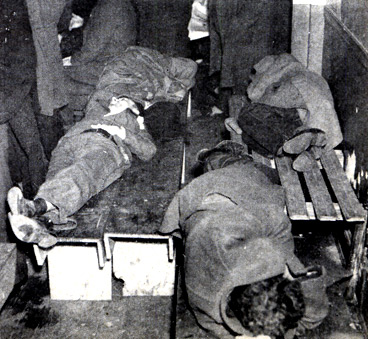 Photograph from Gottlieb, This Is The NMU (1956), courtesy of Tamiment Library, New York University.
Photograph from Gottlieb, This Is The NMU (1956), courtesy of Tamiment Library, New York University.
Zalon, recorded in an oral history with Debra Bernhardt and Joe Doyle, May 29, 1980:
Then when the strike, I actually went 17 days that I didn’t change my clothes. I had no place to sleep. And we used to sneak into the Seamen’s House on 20th Street. There were couches there—and that’s where we used to sleep. I didn’t eat—I hardly ate the day before… I didn’t know what I was going to do that day, I was actually starving. And I went by the Catholic Worker [soup kitchen]. I didn’t know much about it and I found the Catholic Worker. Well the only time in my life I ever ate peanut butter was that day. They had a lot of peanut butter and fresh white bread, delicious coffee. And I must have eaten about three pounds of bread—and a whole jar of peanut butter, about six cups of coffee. And then I rolled up about five or six cigarettes. I walked out of there I felt like I was a millionaire.
At night, strike headquarters doubled as a dormitory/flop house. The nearby Waterfront Section of the Communist Party set up army cots, complete with donated blankets, for homeless strikers. Strikers earned a “flop” in a Bowery flophouse for picket duty—and many citizen supporters allowed strikers to sleep on the floors of their apartments.
Madison Square Garden Rally
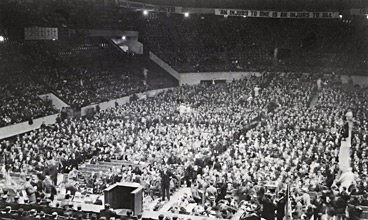 Photograph from Gottlieb, This Is The NMU (1956), courtesy of Tamiment Library, New York University.
Photograph from Gottlieb, This Is The NMU (1956), courtesy of Tamiment Library, New York University.
Strike veteran Barney Lynch, from an oral history recorded by Joe Doyle August 6, 1982:
I didn’t know what a decent meal was. I didn’t know what a decent bed was. I sat in a restaurant in Chelsea there, I sat in there two or three nights, hungry, smell of food. I couldn’t even get a cup of coffee.
I come down, walked down one night from Madison Square Garden, Bridges was up there speaking. When I come outside it was pouring. I’ll never forget it, I had a camel-hair coat. I wasn’t long off a ship. That camel-hair coat was soaking. And I sat in the YMCA that night, Seamen’s YMCA, in my wet clothes.
Sixteen thousand New Yorkers filled Madison Square Garden on Dec. 17, 1936 to support the striking seamen.
Harry Bridges Speaks at Rally
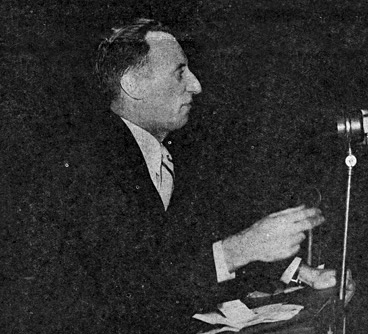 Photograph from I.S.U. Pilot, Dec. 19, 1936, courtesy of Tamiment Library, New York University.
Photograph from I.S.U. Pilot, Dec. 19, 1936, courtesy of Tamiment Library, New York University.
Legendary West Coast longshore leader Harry Bridges headlined the Dec. 17th Madison Square Garden rally for striking seamen. Newspaper Guild president Heywood Broun, Joe Curran, strike leader William McQuistion addressed 16,000 supporters. McQuistion mesmerized the crowd with an account of the shooting in Houston, Texas of rank-and-file seaman Johnny Kane, shot outside union hall by Houston Eastern and Gulf Coast (I.S.U.) port agent Wilbur Dickey. Taps was played in Kane’s memory. Johnny Kane died two days before the rally.
Petition to Oust Corrupt ISU Officers
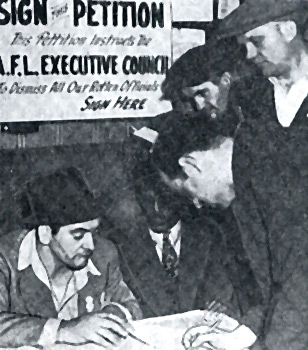 Photograph from I.S.U. Pilot, Nov. 20, 1936, courtesy of Tamiment Library, New York University.
Photograph from I.S.U. Pilot, Nov. 20, 1936, courtesy of Tamiment Library, New York University.
At strike headquarters on 11th Avenue, seamen signed a petition to the A.F. of L. to remove the corrupt leaders of the International Seamen’s Union.
Ships Idled by Strike in December, 1936
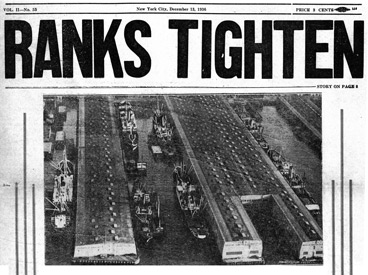 Photograph from I.S.U. Pilot, Dec. 1936, courtesy of Tamiment Library, New York University.
Photograph from I.S.U. Pilot, Dec. 1936, courtesy of Tamiment Library, New York University.
There were moments during the long Fall Strike when victory seemed close. The American Range Line, the Prudential Steamship Corporation, the Trans- Oceanic steamship corporation, and the American Foreign Export Line independently agreed to strikers’ demands for West Coast wages and working conditions—but I.S.U officials nixed one contract and the East Coast longshoremen’s union nixed another.
Mounted Police Follow Strikers
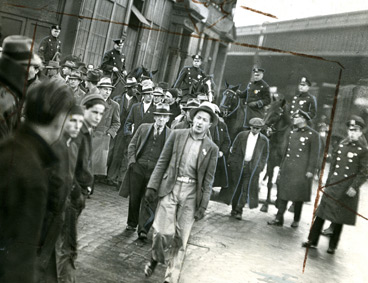 Daily Worker/Daily World Photographs Collection, Tamiment Library, New York University.
Daily Worker/Daily World Photographs Collection, Tamiment Library, New York University.
Strike veteran Barney Lynch, from an oral history recorded by Joe Doyle in August, 1982:
You had the Church against you. The Democratic Party was against you. The police were against you. The city officials were all against you. The longshoremen were against you. To everybody you’re a communist. And most of the guys didn’t—wouldn’t have been able to tell—what’s a commie? They weren’t most of them. They were just honest, true rank-and-filers that had so much to gain and so little to lose.
The photo is from New York City, December, 1936. Strike veteran Barney Lynch spoke about the solidarity of the strikers in 1982:
You won’t find men like we had that Fall Strike. They’d be sleeping on a YMCA floor, a tile floor. One person rented the room and everyone else snuck in to sleep on the floor. The steam rising from their wet clothes… Three or four a.m. somebody’d come in: “All Right! Out! Strike Duty!” And off they go to Brooklyn or East New York so some such place. Not a word of complaint. Everybody just got up and went out.
“Honorably arrested”
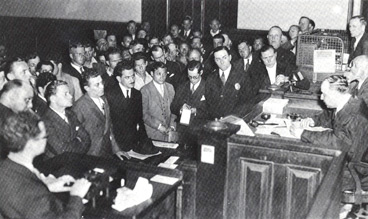 Photograph from Raskin, On a True Course (1967), courtesy of Tamiment Library, New York University.
Photograph from Raskin, On a True Course (1967), courtesy of Tamiment Library, New York University.
Hundreds of strikers had their picket cards stamped “Honorably Arrested” in the course of the Fall Strike. Strike veteran Joe Stack explains:
…we had guys that went in jail—most of the guys went to Rikers Island, but some of them went in further than that. We had a couple that went to Sing Sing. They beat up finks and rolled the finks. They were charged with robbery. But that was the standard practice of the seamen, you never dumped a fink that you didn’t roll.
Because the money went into the Soup Kitchen. That’s where we got our money, most of it. And it was an understood thing—you rolled these here finks. You take their money—they’ve got our money. You didn’t dump a fink if you didn’t take his goddamned money and turn it over to the soup kitchen. Where else could they get any money?
And so consequently there were a few guys that went to jail. …The strike committee passed a resolution that anybody that went to jail for union activity must get stamped on his card: “Honorably Arrested for strike duty.” We had a couple of guys that. Even when the strike was over and the union was formed, we had several people that were in jail for four or five years—in Sing Sing and other places. And we used to send them up a weekly allowance—some cigarettes and stuff like that—was passed by the strike committee and then when the union was formed the union took that over to see that these guys were provided for.
To Washington, in the Rain
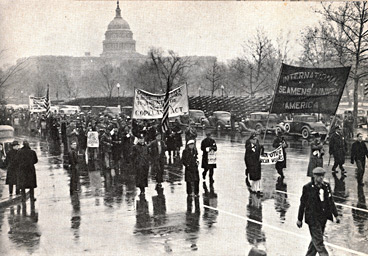 Photograph from Gottlieb, This Is The NMU (1956), courtesy of Tamiment Library, New York University.
Photograph from Gottlieb, This Is The NMU (1956), courtesy of Tamiment Library, New York University.
Greta Kornfeld, from an oral history recorded by Joe Doyle August 4, 1982:
…they had a meeting of the rank-and-file, and they decided to march to Washington. So I had a car. So there was a sheet painted [with a] big red cross over the roof of the car. So I was driving “the Red Cross car.” We drove up to Baltimore, and we stopped at Paddy Whalen’s house. [Paddy Whelan was the leader of rank-and-file seamen in Baltimore.] We got there early in the morning, cause we started out right after the meeting. And we shook Paddy Whelan awake. And I’ll never forget, he was laying in bed. And he tried to open his eyes. He reached down for a bottle [of whiskey]. And he took a slug out of his bottle so he’d be able to wake up. It was some night—and this was a thing I’d never seen before. But anyway so I was with the men that couldn’t get the 40 mile walk [to Washington, D.C.] Those that dropped out – got blisters and couldn’t walk any further – we put them in the car. When the car was full, I shot up to Washington. I’d come back and pick up men. I shuttled back and forth. We got to Washington. And then we sent a delegation to Madame Perkins [U.S. Secretary of Labor] And I’ll never forget that meeting. We were [saying]: “You’ve got to do something. You got to do something. These men are hungry. They’re exhausted. They haven’t had any food.
So they opened up one of the lunch rooms in one of the government buildings and they took them all in to eat. And after we had our demonstration they brought up army trucks and they drove them back to Baltimore. At the demonstration it was very exciting. I remember none of us had the place to sleep so we had no money so one of the men and I went into a rooming house and we rented a room. I was Mrs. “So and So” and we rented the room and when the landlady wasn’t looking one by one the men would come in—there must have been 20 in that room that night all over the floor they slept.
In mid-January, with the strike seemingly doomed, strikers embarked on a bold lobbying campaign, marching from Baltimore to Washington D.C. to protest new legislation which seamen dubbed “The Dog Collar Act.” A captain’s rating of a seaman at the end of a voyage was memorialized in a “discharge,” indicating what job (O.S., A.B.—able-bodied seaman, etc.) and whether the man’s work and work ethic were satisfactory. Seamen kept the good ones, discarding the bad ones. A Senator, Royal S. Copeland, proposed a permanent ID book which recorded all the captains’ ratings—good and bad. Thousands of seamen descended on Washington D.C. to protest the new law.
Strike Strategy Committee
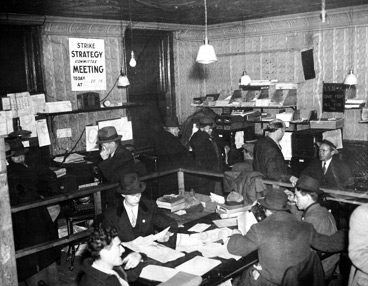 Photograph from Daily Worker/Daily World Photographs Collection, Box 157, folder 22872, courtesy of Tamiment Library, New York University.
Photograph from Daily Worker/Daily World Photographs Collection, Box 157, folder 22872, courtesy of Tamiment Library, New York University.
The Strike Strategy Committee directed strikers from this upstairs 11th Ave. headquarters. By Dec. 23rd when this photograph was taken, the strike was clearly lost. However, hard-liners on the committee refused to accept defeat and adopt the strategy of sending strikers back aboard the ships to organize.
Going on to Organize
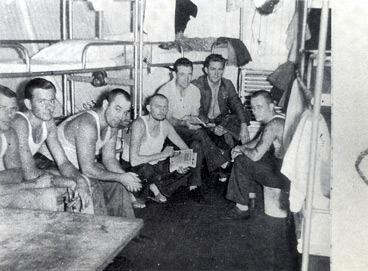 Photograph courtesy of The New York Public Library Picture Collection.
Photograph courtesy of The New York Public Library Picture Collection.
Jack Lawrenson on the Strike Strategy Committee reported that the number of strikers registered for picket duty had fallen from 30,000—down to 3,000. Wiser heads prevailed. A vote was taken January 21, 1936 to call off the Fall Strike and “organize aboard the ships.”
Giving birth to the National Maritime Union took the combined sacrifices of the two bitter strikes in the Spring and Fall of 1936—and the all-important follow-up work of going back aboard the ships after each of the strikes was defeated to persuade non-strikers to throw in their lot with rank-and-filers seeking to oust I.S.U. leadership.









